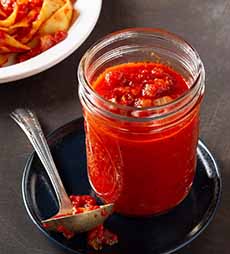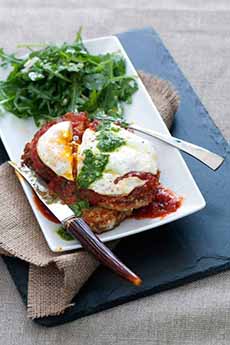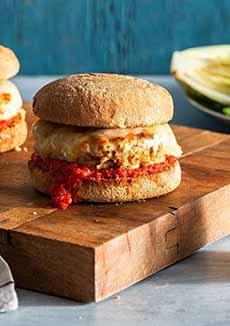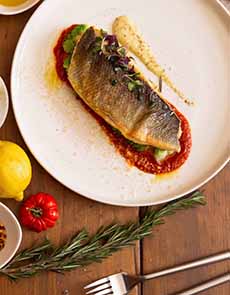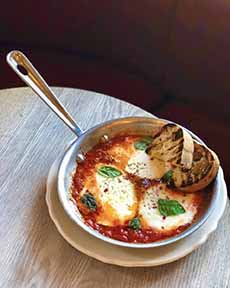TIP OF THE DAY: Homemade Marinara Sauce Recipe in 20 Minutes!
|
|
March is National Sauce Month, and before the month is out we have a tip for people who have never made homemade marinara sauce—the simplest pasta sauce after butter or olive oil—before. This easy recipe will show you how you can have a simple pasta sauce on the table in just 20 minutes—pretty much the time it takes to boil water and cook the pasta. In fact, you can make this simple homemade marinara sauce recipe in the time it takes to boil the pasta! Thanks to our friends at Taste Of Home for the tip, and to Deborah Markwood of Chester, Virginia who submitted the recipe. In addition to the marinara sauce recipe below, you’ll find: > Uses for marinara sauce, beyond Italian dishes. > The difference between marinara and tomato sauce. > The history of marinara sauce. Marinara is a simple tomato sauce made with garlic, crushed red pepper, and basil. It’s not the same as tomato sauce. See below for the difference. It can be pepped up with the addition of capers, olives, other spices (including those from other cuisines, such as curry), and a splash of wine, among many other variations. A 28-ounce can of Cento crushed tomatoes is $2.19 at Target. Pasta sauces in that price range typically have a lot of sugar (partially to compensate for lesser-quality tomatoes and herbs). Marinara is short for “alla marinara,” Italian for “seafaring,” which colloquially translates to “mariner style” or “sailor-style.” The name harkens back to when it was the preferred sauce to top the meals of Italy’s merchants during long expeditions at sea [source]. Tomatoes, a New World crop, first arrived in Europe in 1529 with the return of the Spanish conquistadors. In 1519, Cortez found it growing in Montezuma’s gardens, and it became part of the culinary bounty brought back to Spain along with cacao, chiles, potatoes, turkey, and other foods. Here’s the history of tomatoes. Marinara sauce was developed later in the 16th century, likely in the Naples or Sicily area of southern Italy. Pasta had arrived much earlier, with Arab traders in the 12th century and earlier with Arab invaders of Sicily in the 8th-9th centuries (the history of pasta). The first reference to a tomato sauce is in the 1692 Italian cookbook “Lo Scalco alla Moderna” (The Modern Steward) by Chef Antonio Latini. Here’s an interpretation of the original recipe. A recipe for pasta with tomato sauce appears in the 1790 Italian cookbook, L’Apicio Moderno, by chef Francesco Leonardi. 1. COOK the vegetables. Heat the olive oil over medium heat in a small saucepan. When the oil is hot and shimmering, add the onion. Cook, stirring, until the onion is tender, about 3 to 5 minutes. 2. ADD the brown sugar, minced garlic, basil, and oregano. Cook for an additional minute, until the garlic is fragrant and the spices have bloomed in the oil. 3. ADD the can of crushed tomatoes along with the bay leaf, salt, and pepper. Bring the sauce to a boil before reducing the heat to medium-low. Simmer, uncovered, for about 10 minutes, until the liquid is reduced and the flavors have come together. 4. TASTE and adjust the salt if desired. Remove the bay leaf before serving. We’re skipping over the obvious Italian dishes, the less obvious (polenta, e.g.), and the Italian fried dipping group (arancini, calamari, mozzarella and zucchini sticks). You already know to serve marinara sauce with them. Instead, we offer some newer takes: She dilutes the sauce with water and adds canned beans, mini elbows, grated parmesan, and mixed chopped vegetables (cook until the vegetables are tender). While marinara is a simple, relatively thin sauce, tomato sauce is a thick, rich, complex sauce. It’s one of Escoffier’s five classic French mother sauces: sauce tomat. While there are variations of sauce tomat, a French cook starts off with salt pork or bacon, onions, carrots, and a roux (flour and butter). Then, fresh tomatoes, bay leaves, garlic, and veal stock (or in modern times, the more readily available chicken stock) are added, and the sauce simmers for hours. The long simmer time thickens the sauce and deepens the flavors. Sunday gravy or Sunday sauce is an American version of the French tomato sauce. It usually contains additional meat, such as pork ribs, ground beef, or Italian sausage [source]. Tomato sauce’s rich flavor and thick texture make it better suited for smothering foods, as with gravy. Tomato sauce can be used for chicken cacciatore or pasta, but the complexity of flavors would get lost under the mozzarella and toppings of pizza. |
|
|
|
||
